
Blog Post
How To Assess Reading Effectively for K–3 Students

In teaching, the value of reliable and valid assessments of early reading progress cannot be overstated. It’s through these assessments that educators can make informed decisions that help prevent reading difficulties and improve students’ academic outcomes.
Different assessment instruments serve different purposes. Teachers need to keep the specific purpose in mind when selecting assessments and determining when in the instructional sequence to use them.
In the primary grades, reading instruction includes teaching discrete skills. These specific skills and strategies provide the foundation for building fluency and reading comprehension. Because of the need for mastery of these critical underlying skills, reading assessments in the primary grades should be frequent and begin with the evaluation of these discrete skills.
Through the use of precise assessments that inform instruction and a preventive mindset, it’s possible to pave the way for a generation of students who thrive academically. To develop an assessment plan, teachers first need to understand the complexity of the reading process and why some students experience difficulty in learning to read.
The Complexity of Learning to Read
We can look to the Simple View of Reading to understand the components required for successful reading. Developed by Gough and Tunmer in 1986, the Simple View of Reading framework presents the components necessary for reading comprehension as a mathematical equation. These two components are:
- The ability to recognize (or decode) words within the text
- The ability to comprehend the language being decoded.
The combination of these two components forms the basis of reading comprehension.
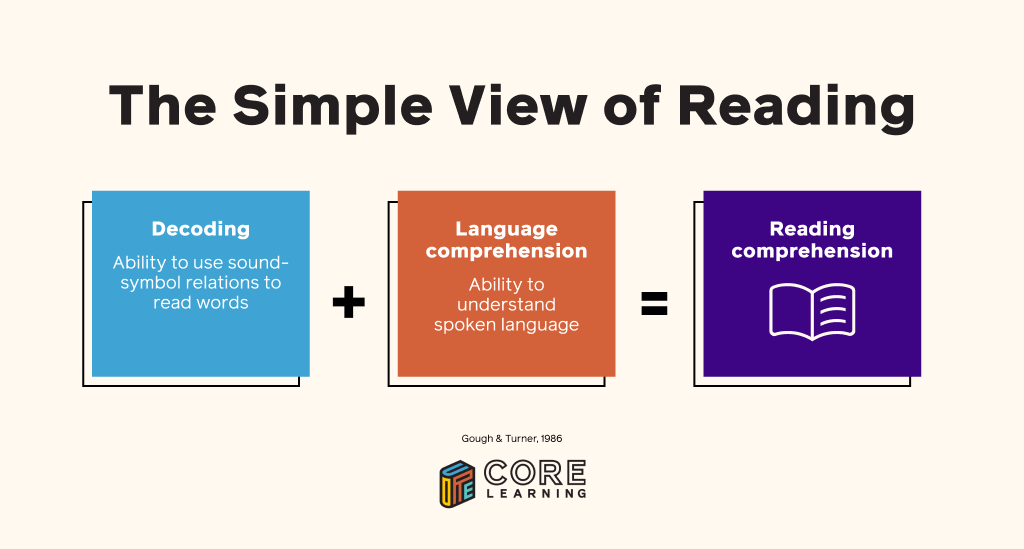
Another useful visual representation of skilled reading is Scarborough’s Rope, which further illustrates the subsets of skills that make up language comprehension and word recognition. By honing in on the subsets of word recognition like phonological awareness and decoding and subsets of language comprehension like vocabulary and language structures, we can identify the specific ‘strands’ a student must master in their journey toward reading comprehension. A student needs to weave together all the strands successfully to be a good reader. Many students fail to develop the decoding skills necessary for automatic word recognition because they are not aware that spoken words are composed of units of sound (phonemes). Poorly developed word recognition skills are the most pervasive and debilitating source of reading difficulty (Adams, 1990).
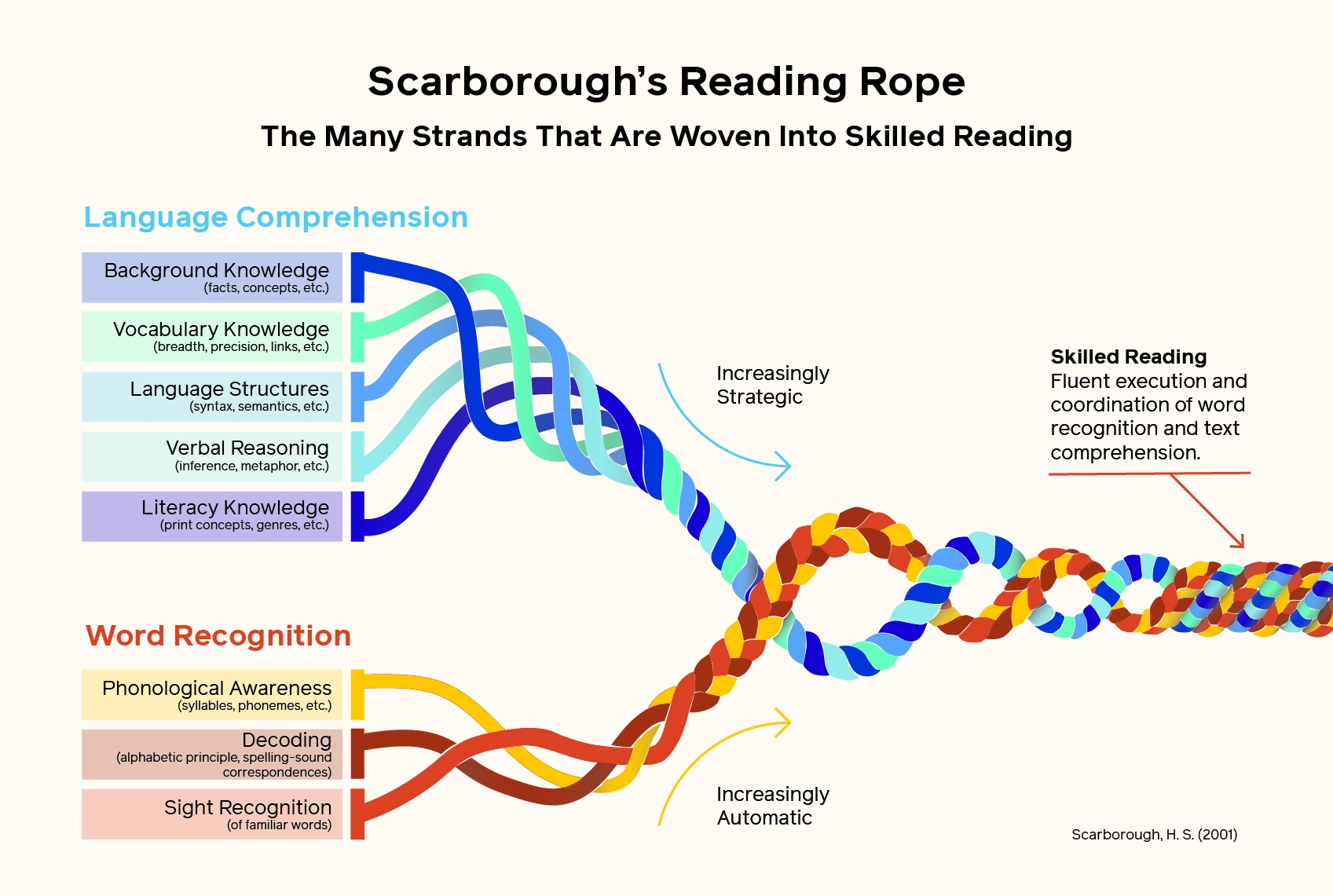

Developing a Comprehensive Assessment Plan
In an effective reading program, assessment informs instruction. Teachers need to utilize assessments that isolate the two major components of reading comprehension in order to best guide instruction. Moreover, in the primary grades, it is critical to frequently assess the specific skills that provide the foundation for fluency and comprehension.
A comprehensive assessment system includes four broad types of assessment: screening, progress monitoring, diagnostic assessment, and outcome assessment. Collectively, these assessments assist the teacher in identifying who may be at risk for reading difficulties, targeting areas of individual strength and needed support, monitoring student reading development, and planning appropriate instruction. In all cases, teachers need to understand the expected components and subskills to achieve reading mastery to best utilize assessment results.
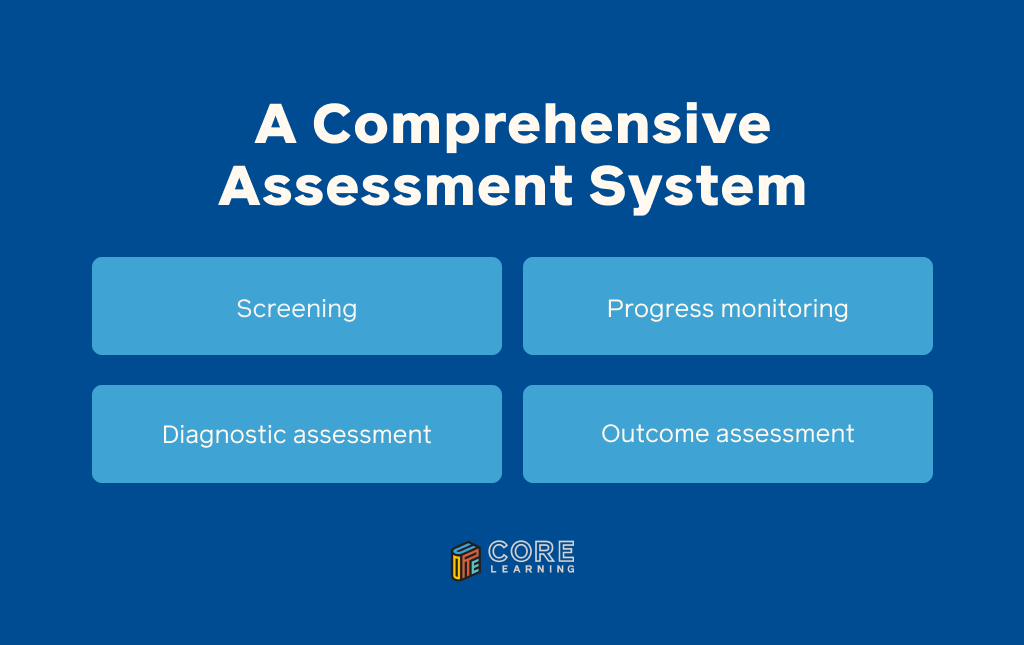
Universal Screening
Screening tests provide information about the knowledge and skill base of the student. They are useful for determining an appropriate starting point for instruction and for planning instructional groups.
Universal screening also plays a vital role in identifying students who may be at risk of reading difficulties and need additional support in their early years of schooling, particularly in kindergarten. Screening allows us to gather valuable information that can guide our instructional decisions and interventions.
For the foundational reading skills, researchers have determined which measures are most predictive of reading difficulties based on the grade level of the student and the particular point in time. For example, when screening kindergarteners, it’s essential to include measures of phonemic awareness, as this skill is particularly relevant to early reading development. Beginning in the fall or winter of first grade, incorporating assessments of oral reading fluency becomes more critical. The table below provides research-validated recommendations for areas to screen by grade level. By following test publisher guidelines for curriculum-based assessments like AIMSweb, DIBELS and FastBridge, teachers can ensure that they are administering the screening measures with the strongest predictability of risk at the appropriate points in time.
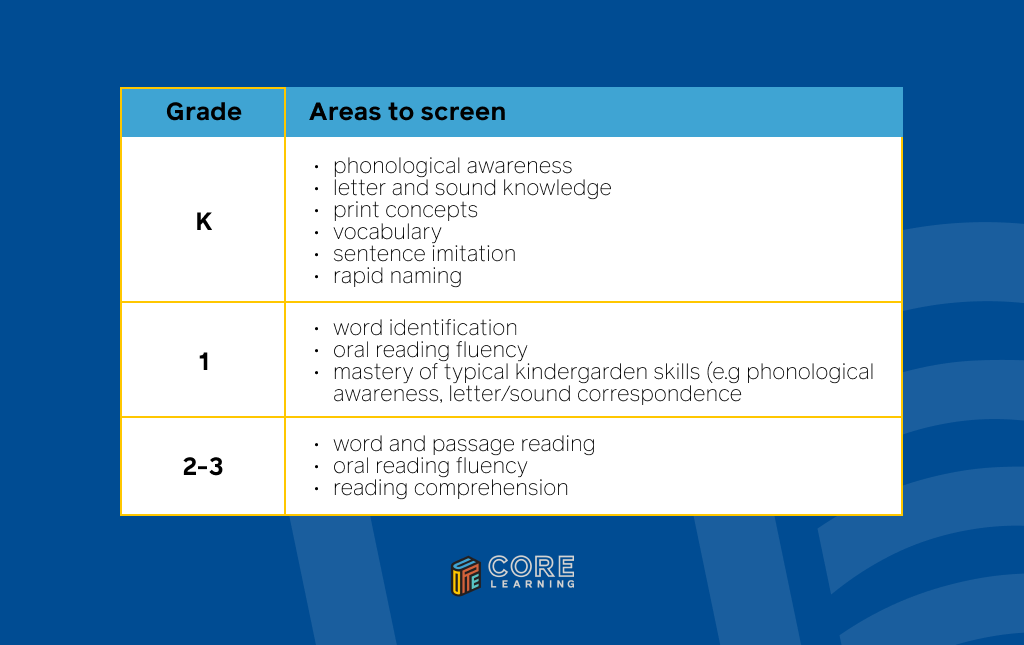
Table 1: Predicting Students at Risk for Reading Difficulties
Source: National Center on Response to Intervention (January, 2013)
Based on the universal screening, we can identify students who exhibit risk factors. Although the screenings may not provide specific reasons for why the student is at risk, they serve as an important starting point for instruction. The focus then shifts to ensuring that students who are identified as at risk receive robust core instruction and any additional support they may need. Monitoring the progress of these students becomes essential to gauge the effectiveness of the instruction and make any necessary adjustments along the way.
Diagnostic Assessments
Teachers will need to collect additional information for some students. If a student does not reach grade-level benchmarks as measured by regular screening, administering additional diagnostic assessments can help guide Tier 1 small group differentiated instruction as well as provide additional information to design targeted Tier 2 support.
Diagnostic assessments delve deep into specific skill areas that require attention. While these assessments may take longer to administer, they provide a comprehensive understanding of a student’s strengths and areas of needed support in a particular skill. For example, a diagnostic assessment may focus solely on phonological awareness, specifically segmentation, by assessing segmentation at the sentence, syllable, and phoneme levels. This allows us to pinpoint the exact areas in the skill progression that a student has mastered so we can tailor our instruction accordingly.
One diagnostic assessment that can be particularly useful for K–3 learners is CORE Learning’s Phonics Survey. This assessment specifically targets phonics skills and gives precise insights into a student’s phonics and decoding abilities through tests of letters and sounds as well as reading real and pseudowords. The CORE Phonics Survey and many other assessments can be found in CORE Learning’s Assessing Reading: Multiple Measures. This resource has assessments that assist in identifying skill gaps across the five essential elements of reading and can be used diagnostically to supplement any assessment system in use.
Diagnostic assessments eliminate guesswork. Teachers no longer have to rely on assumptions or general observations, but can instead rely on concrete data to guide instruction.
Progress Monitoring
Progress monitoring assessments are used to determine whether students are making adequate progress and also to determine whether instruction needs to be adjusted. Progress monitoring measures include curriculum-embedded assessments such as unit tests, which measure to what extent students have learned the material taught from the specific curriculum being implemented. They also include general or external measures for assessing critical reading skills such as phonemic awareness, phonics, fluency, vocabulary, or comprehension. Curriculum-based measurement (CBM) is an assessment tool that can also be used for progress monitoring.
As part of Tier 1 instruction, it is recommended that all students be screened three times a year (fall, winter, spring). This three-time-a-year screening can also be considered to be a type of progress monitoring for all students. Students who do not reach grade-level benchmarks on the fall, winter, and spring assessments will require more frequent monitoring to guide ongoing instructional decision making. Those students not reaching grade-level benchmarks should be receiving support as part of Tier 2 or 3 instruction. Progress monitoring for students in Tier 2 or 3 intervention should occur bi-weekly or weekly, respectively.
Progress monitoring provides valuable data points that help us track individual student growth and make data-informed instructional decisions. The ability to monitor progress is essential to ensuring that students are making the desired academic gains. By continuously assessing student progress and analyzing the results, we can refine our strategies, tailor interventions, and ensure that students are on track to reach their goals.
Outcome Assessment
Outcome assessment is often used at the end of major units of instruction and at year’s end. Annual state-level required assessments are an example of outcome assessments. Outcome assessments provide data about student accomplishments and are useful for planning the next major segment of instruction and for determining changes to a school’s curriculum. They also provide programmatic information for large groups of students.
Promoting Reading Success for All K–3 Learners
A comprehensive assessment system plays a pivotal role in helping teachers to enhance students’ reading skills and improve overall student outcomes. The Effective Reading Assessment Systems chart below outlines how to best utilize screening, progress monitoring, diagnostic and outcome assessments across kindergarten through Grade 3.
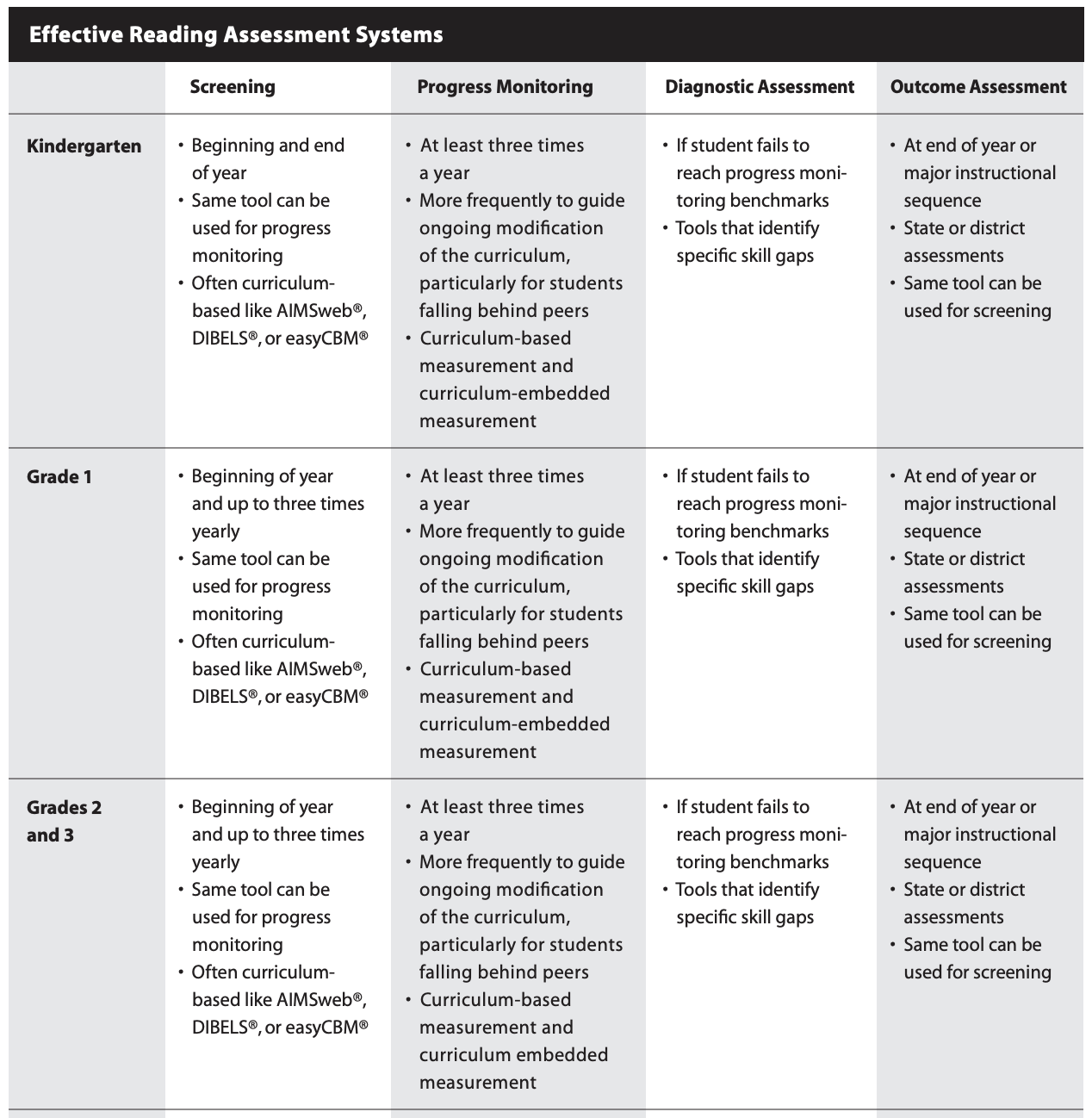
Source: Assessing Reading: Multiple Measures, Revised Second Edition
To support educators in developing a system of assessment, CORE Learning has published Assessing Reading: Multiple Measures, Revised 2nd Edition. As noted above, Assessing Reading: Multiple Measures contains a collection of formal and informal reading assessments for use with students in kindergarten through Grade 12. These assessments assist the teacher in targeting areas of strength and needed support, monitoring student reading development, and planning appropriate instruction.
Assessing Reading: Multiple Measures provides an Assessment Sequence for Students in Kindergarten through Grade 3 that utilizes the collection of formal and informal reading assessments provided in the text. (See chart below.) This sequence begins with assessment of the most discrete reading skills (e.g., phonological awareness, phonics) and goes on to include assessments of fluency, vocabulary and reading comprehension. This is in contrast to the suggested assessment sequence for students in Grades 4-12 that begins with assessment of the most global skills (i.e., reading comprehension). Note that many of the measures on the chart can be replaced by teacher observation, informal checklists and materials that come with a core reading program. It is also important to note that not all students will need all assessments.
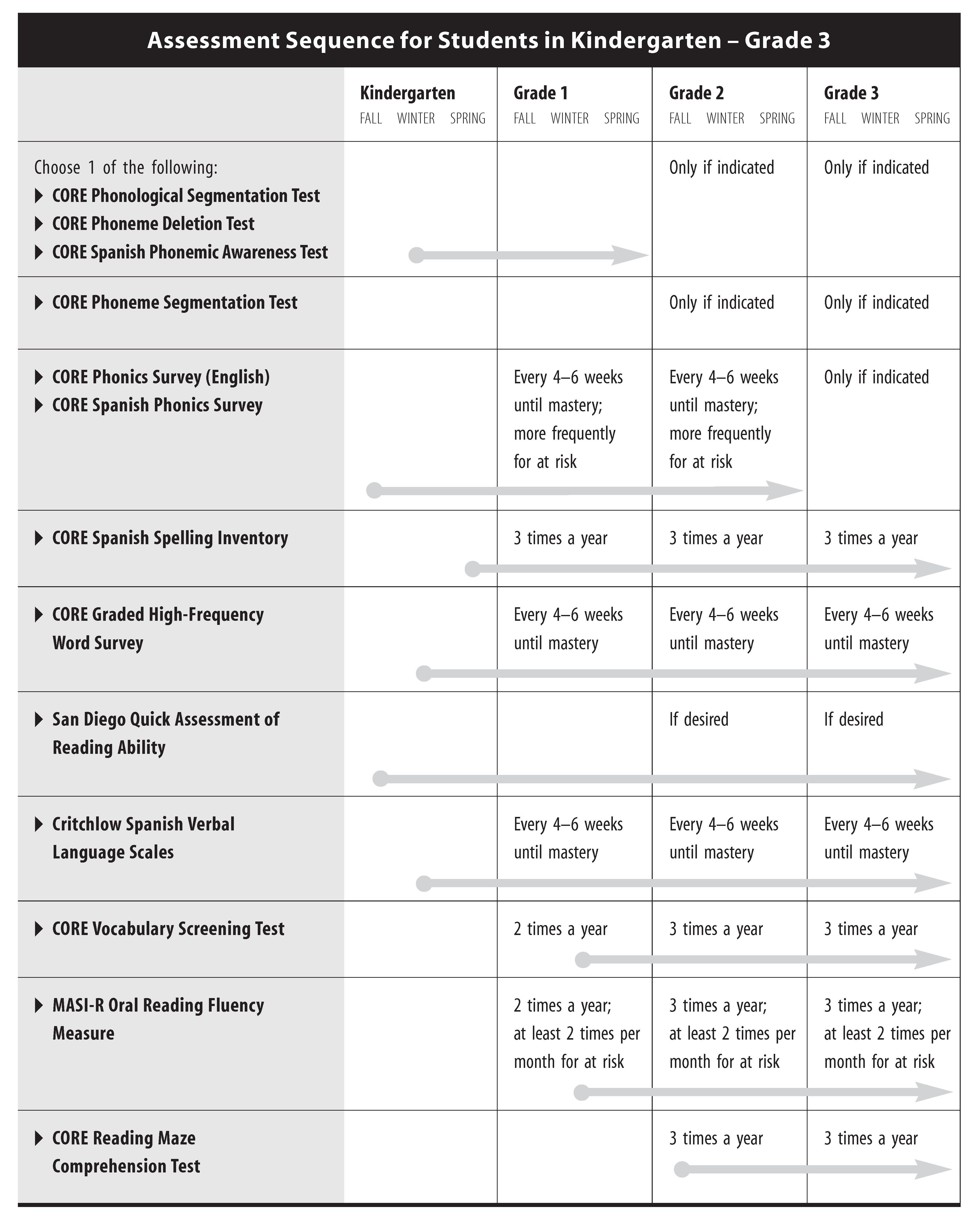
Source: Assessing Reading: Multiple Measures, Revised Second Edition
Click here to download more sample pages from Assessing Reading: Multiple Measures.






